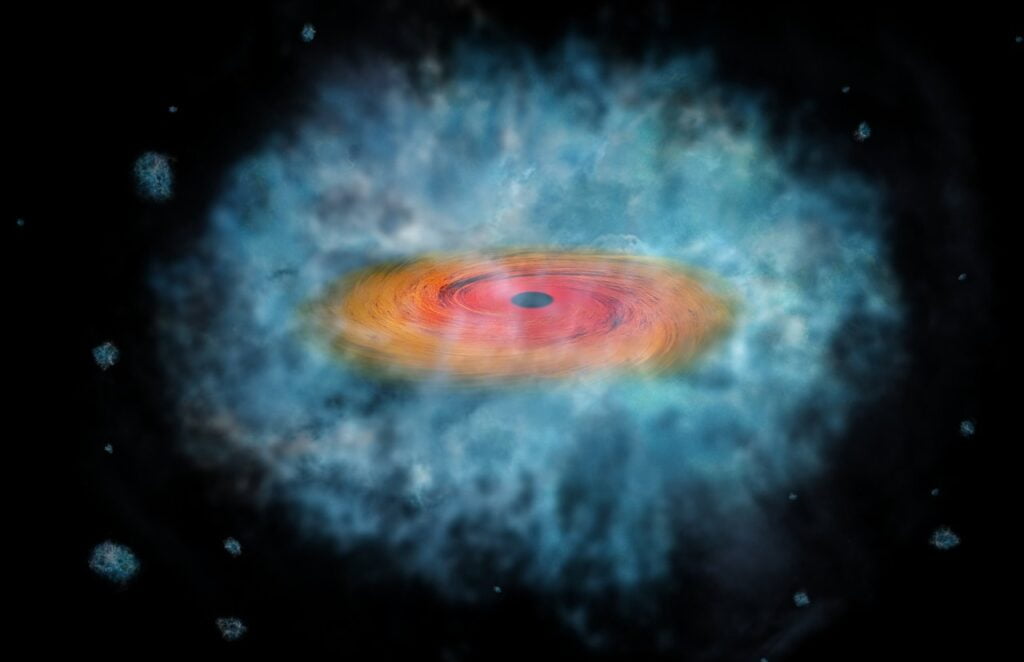Astrophysicist Priyamvada Natarajan has long posited that black holes can form independently of stars. Recent astronomical observations lend credence to her theory, potentially solving a longstanding mystery about the universe’s earliest black holes.
How Do Black Holes Form Without Stars?
As astronomers delve into the early history of the universe, they’ve discovered numerous gigantic black holes that seem to have matured much faster than previously thought possible. Traditionally, black holes form from the remnants of large stellar explosions, growing in mass as they consume nearby gas. However, new findings suggest an alternative formation method that doesn’t involve stars.
What Inspired Natarajan’s Interest in Black Hole Formation?
Natarajan’s fascination with the unseen elements of the universe, like dark matter, dark energy, and black holes, drove her to explore these enigmatic objects. As a graduate student, she began treating black holes as populations, much like a biologist studies species in a rainforest. Now an astrophysicist at Yale University, Natarajan focuses on understanding how these “cosmic creatures” are born and evolve.
What Is the Traditional Black Hole Formation Theory?

Typically, black holes emerge when massive stars die and collapse under their own gravity, leaving behind a dense core. This process has been the accepted narrative for black hole formation. However, discoveries of supermassive black holes in the early universe challenge this model. Observations have shown black holes with masses up to a billion times that of the sun, existing when the universe was only one to two billion years old. This rapid growth seemed impossible under the traditional model, prompting Natarajan to explore new possibilities.
What Is the Direct-Collapse Black Hole Theory?
In 2006, Natarajan and her colleagues proposed that black holes could form directly from collapsing gas clouds, bypassing the star formation stage altogether. This “direct-collapse” theory suggested that under certain conditions, a gas disk could collapse directly into a massive black hole, starting its existence with a mass thousands of times that of the sun.
How Did the Astronomy Community React to This Theory?
Initially, the community was skeptical. Many questioned whether the process was efficient enough to happen in the real universe. At the time, observational evidence from the early universe was limited. However, the advent of powerful telescopes like the James Webb Space Telescope (JWST) offered hope for validating this theory.
What Recent Observations Support the Direct-Collapse Theory?
Last year, a collaborative effort involving the JWST and the Chandra X-ray Observatory provided compelling evidence supporting Natarajan’s hypothesis. They identified a distant, bright black hole that aligns with the predicted characteristics of a direct-collapse black hole.
How Did This Discovery Come About?
Natarajan and her team predicted that in the early stages, a direct-collapse black hole could be as massive as the stars in its galaxy, outshining them significantly. This prediction led them to focus on areas with gravitational lenses, like the galaxy cluster Abell 2744, which could magnify distant objects. Their efforts paid off when a colleague, Akos Bogdan, identified a galaxy whose spectral data matched their predictions, providing strong evidence for the existence of direct-collapse black holes.
What Does This Discovery Mean for Our Understanding of the Universe?
The confirmation of direct-collapse black holes revolutionizes our understanding of black hole formation. It suggests that there are multiple pathways for black hole creation, opening up new avenues for research.
What Are the Next Steps in Black Hole Research?
Natarajan plans to explore other potential pathways for black hole formation and their unique observational signatures. This research could further refine our understanding of the early universe and the role black holes play in galactic evolution.
Exploring the Implications of Direct-Collapse Black Holes

The validation of Natarajan’s theory not only answers some questions but also raises new ones about the nature of black holes and the early universe.
How Does This Discovery Affect Our View of Black Hole Evolution?
Understanding that black holes can form without stars means we must reconsider the timeline and mechanisms of black hole growth. These findings indicate that supermassive black holes could form much more quickly than previously thought, affecting our models of galaxy formation and evolution.
What Other Mysteries Could This Discovery Help Solve?
The existence of direct-collapse black holes could help explain the rapid appearance of supermassive black holes in the early universe, which has puzzled scientists for decades. This discovery may also provide insights into the distribution of dark matter and its role in black hole formation.
Conclusion: The Future of Black Hole Research
The discovery of direct-collapse black holes marks a significant milestone in astrophysics. It highlights the importance of innovative theories and the advancements in observational technology that make such discoveries possible. As Natarajan and her colleagues continue to explore the universe’s earliest epochs, we can expect further breakthroughs that will deepen our understanding of the cosmos.
How Does This Discovery Influence Future Research?
This discovery encourages scientists to think outside traditional models and consider alternative formation scenarios for other cosmic phenomena. It also underscores the value of interdisciplinary collaboration and the need for continued investment in advanced telescopes and observational tools.
What Can We Learn from Priyamvada Natarajan’s Journey?

Natarajan’s journey from theoretical predictions to observational validation exemplifies the dynamic nature of scientific inquiry. Her work reminds us that persistent curiosity and innovative thinking are crucial for uncovering the universe’s secrets. This era of discovery reaffirms that we are indeed living in the golden age of cosmology, with many more mysteries yet to be solved.


Pingback: Rafah (Israel-Gaza War): President Biden's Stance on the Conflict and Its Impact - American Report